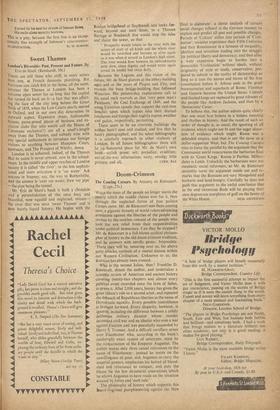Sweet Thames
London's Riverside: Past, Present and Future. By Eric de Marc. (Reinhardt, 30s.)
THERE are still those who sniff, in more senses than one, at French domestic plumbing. But Parisians can catch fish in the Seine, all the same, ti hereas the Thames at London has been a noisome open sewer for so long that the capital has turned its back on it—a fact that was affect- ing the face of the city long before the Great Stink of 1858, when the Law Courts nearly moved to Oxford, and in our own day determines its outward aspect. Expensive shops, fashionable houses, purse-proud places of business and ex- clusive clubs (for who would call the House of Commons exclusive?) are all a smell's-length away from the Thames, and nobody tries with any special enthusiasm to introduce our foreign visitors. to anything between Hampton Court, upstream, and The Prospect of Whitby, down. •
London is so ashamed, indeed, of the Thames that its name is never uttered, save in the school- room. In the middle and upper reaches of London society it is called 'the river'; to the less sophisti- cated and more articulate it is 'ver water.' Ask anyone in Stepney, say, the way to Rotherhithe, and the answer is 'over ver water; frew ver pipe' —the pipe being the tunnel.
Mr. Eric de Mare's book is both a chronicle and a perambulation of this once busy and beautiful, now squalid and neglected, stream— the river that was once 'sweet Thames' and is now barely liquid history. He begins with the
Roman bridgehead at Southwark and looks for- ward, beyond our own times, to a Thames Barrage at Woolwich that would stop the tides and sluice the sewer, so that Prosperity would return to the river with the return of craft of all kinds and the whole river would be revivified and become as alive again as it was when it served as London's high street. The river would flow between its embankments with slow, clean dignity and would never again reveal its sordid bed twice daily.
Between the Legions and this vision of the future, Mr. de Mare glances at the abbey-building ages and at the years of Plague and Fire, and records the busy bridge-building that followed Waterloo. His present-day explorations call to his mind such marvels as that 'very poor man's Pantheon,' the Coal Exchange of 1849, and the smug yictorian camels that support the cast-iron benches upon which typists take their diurnal luncheons and tramps their nightly repose, weather and police, respectively, permitting.
There seem to be no riverside buildings the author hasn't seen and studied, and few that he hasn't photographed, and his select bibliography is a scholarly reproach to other students of London. In all future bibliographies there will be au honoured place for Mr. de Mare's own book—stylish prose; wit; prejudice; erudition; out-of-the-way information; nasty, smudgy little


































 Previous page
Previous page